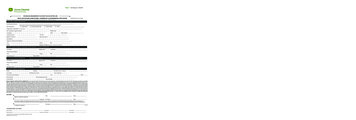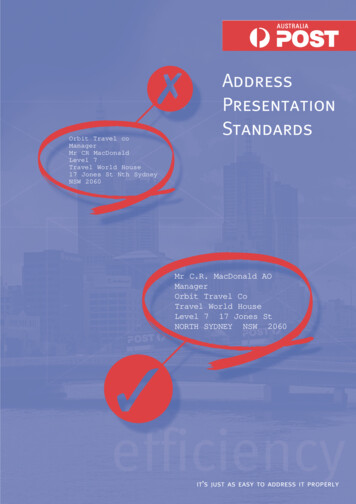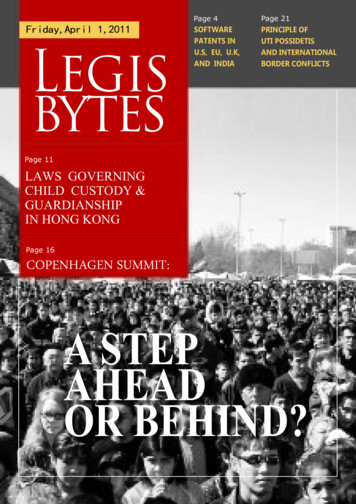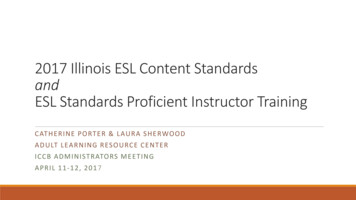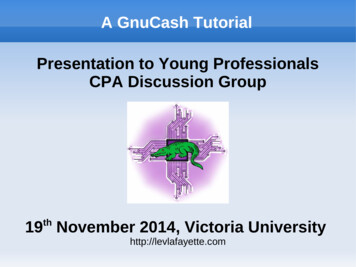
Transcription
STANDARDS PRESENTATIONPage 1 of 21TOCALIFORNIA OCCUPATIONAL SAFETY AND HEALTH STANDARDS BOARDTITLE 8, DIVISION 1, CHAPTER 4Subchapter 7. General Industry Safety OrdersAdopt Section 3205 to read:§ 3205. “Shall” and “Should.” [Repealed] COVID-19 Prevention.(a) Scope.(1) This section applies to all employees and places of employment, with the followingexceptions:(A) Places of employment with one employee who does not have contact with otherpersons.(B) Employees working from home.(C) Employees when covered by section 5199.(2) Nothing in this section is intended to limit more protective or stringent state or local healthdepartment mandates or guidance.(b) Definitions. The following definitions apply to this section and to sections 3205.1 through3205.4.(1) “COVID-19” means coronavirus disease, an infectious disease caused by the severe acuterespiratory syndrome coronavirus 2 (SARS-CoV-2).(2) “COVID-19 case”(A) Means a person who:1. Has a positive “COVID-19 test” as defined in this section;2. Is subject to a COVID-19-related order to isolate issued by a local or state healthofficial; or3. Has died due to COVID-19, in the determination of a local health department orper inclusion in the COVID-19 statistics of a county.(B) A person is no longer a “COVID-19 case” in this section when a licensed health careprofessional determines that the person does not have COVID-19, in accordance withrecommendations made by the California Department of Public Health (CDPH) or thelocal health department pursuant to authority granted under the Health and Safety Code orTitle 17, California Code of Regulations to CDPH or the local health department.(3) “COVID-19 exposure” means being within six feet of a COVID-19 case for a cumulativetotal of 15 minutes or greater in any 24-hour period within or overlapping with the “high-riskOSHSB-98(2/98)
STANDARDS PRESENTATIONPage 2 of 21TOCALIFORNIA OCCUPATIONAL SAFETY AND HEALTH STANDARDS BOARDTITLE 8, DIVISION 1, CHAPTER 4exposure period” defined by this section. This definition applies regardless of the use of facecoverings.(4) “COVID-19 hazard” means exposure to potentially infectious material that may containSARS-CoV-2, the virus that causes COVID-19. Potentially infectious materials includeairborne droplets, small particle aerosols, and airborne droplet nuclei, which most commonlyresult from a person or persons exhaling, talking or vocalizing, coughing, sneezing, orprocedures performed on persons which may aerosolize saliva or respiratory tract fluids,among other things. This also includes objects or surfaces that may be contaminated withSARS-CoV-2.(5) “COVID-19 symptoms” means fever of 100.4 degrees Fahrenheit or higher, chills, cough,shortness of breath or difficulty breathing, fatigue, muscle or body aches, headache, new lossof taste or smell, sore throat, congestion or runny nose, nausea or vomiting, or diarrhea, unlessa licensed health care professional determines the person’s symptoms were caused by aknown condition other than COVID-19.(6) “COVID-19 test” means a viral test for SARS-CoV-2 that is:(A) Approved by the United States Food and Drug Administration (FDA) or has anEmergency Use Authorization from the FDA to diagnose current infection with theSARS-CoV-2 virus; and(B) Administered in accordance with the FDA approval or the FDA Emergency UseAuthorization as applicable.(7) “Exposed workplace” means any work location, working area, or common area at workused or accessed by a COVID-19 case during the high-risk period, including bathrooms,walkways, hallways, aisles, break or eating areas, and waiting areas. The exposed workplacedoes not include buildings or facilities not entered by a COVID-19 case.(A) Effective January 1, 2021, the “exposed workplace” also includes but is not limited tothe “worksite” of the COVID-19 case as defined by Labor Code section 6409.6(d)(5).(8) “Face covering” means a tightly woven fabric or non-woven material with no visible holesor openings, which covers the nose and mouth.(9) “High-risk exposure period” means the following time period:(A) For persons who develop COVID-19 symptoms: from two days before they firstdevelop symptoms until 10 days after symptoms first appeared, and 24 hours havepassed with no fever, without the use of fever-reducing medications, and symptomshave improved; or(B) For persons who test positive who never develop COVID-19 symptoms: from two daysbefore until ten days after the specimen for their first positive test for COVID-19 wascollected.OSHSB-98(2/98)
STANDARDS PRESENTATIONPage 3 of 21TOCALIFORNIA OCCUPATIONAL SAFETY AND HEALTH STANDARDS BOARDTITLE 8, DIVISION 1, CHAPTER 4(c) Written COVID-19 Prevention Program. Employers shall establish, implement, and maintainan effective, written COVID-19 Prevention Program, which may be integrated into theemployer's Injury and Illness Program required by section 3203, or be maintained in aseparate document. The written elements of a COVID-19 Prevention Program shall include:(1) System for communicating. The employer shall do all of the following in a form readilyunderstandable by employees:(A) Ask employees to report to the employer, without fear of reprisal, COVID-19symptoms, possible COVID-19 exposures, and possible COVID-19 hazards at theworkplace.(B) Describe procedures or policies for accommodating employees with medical or otherconditions that put them at increased risk of severe COVID-19 illness.(C) Provide information about access to COVID-19 testing. If testing is required under thissection, section 3205.1, or section 3205.2, the employer shall inform affectedemployees of the reason for the COVID-19 testing and the possible consequences of apositive test.(D) In accordance with subsection (c)(3)(B)3., communicate information about COVID-19hazards and the employer’s COVID-19 policies and procedures to employees and toother employers, persons, and entities within or in contact with the employer’sworkplace.NOTE: See subsections (c)(3)(C) and (c)(3)(D) for confidentiality requirements forCOVID-19 cases.(2) Identification and evaluation of COVID-19 hazards.(A) The employer shall allow for employee and authorized employee representativeparticipation in the identification and evaluation of COVID-19 hazards.(B) The employer shall develop and implement a process for screening employees for andresponding to employees with COVID-19 symptoms. The employer may askemployees to evaluate their own symptoms before reporting to work. If the employerconducts screening at the workplace, the employer shall ensure that face coverings areused during screening by both screeners and employees and, if temperatures aremeasured, that non-contact thermometers are used.(C) The employer shall develop COVID-19 policies and procedures to respond effectivelyand immediately to individuals at the workplace who are a COVID-19 case to preventor reduce the risk of transmission of COVID-19 in the workplace.(D) The employer shall conduct a workplace-specific identification of all interactions,areas, activities, processes, equipment, and materials that could potentially exposeOSHSB-98(2/98)
STANDARDS PRESENTATIONPage 4 of 21TOCALIFORNIA OCCUPATIONAL SAFETY AND HEALTH STANDARDS BOARDTITLE 8, DIVISION 1, CHAPTER 4employees to COVID-19 hazards. Employers shall treat all persons, regardless ofsymptoms or negative COVID-19 test results, as potentially infectious.1. This shall include identification of places and times when people may congregate orcome in contact with one another, regardless of whether employees are performingan assigned work task or not, for instance during meetings or trainings and includingin and around entrances, bathrooms, hallways, aisles, walkways, elevators, break oreating areas, cool-down areas, and waiting areas.2. This shall include an evaluation of employees’ potential workplace exposure to allpersons at the workplace or who may enter the workplace, including coworkers,employees of other entities, members of the public, customers or clients, andindependent contractors. Employers shall consider how employees and otherpersons enter, leave, and travel through the workplace, in addition to addressingfixed work locations.(E) For indoor locations, the employer shall evaluate how to maximize the quantity ofoutdoor air and whether it is possible to increase filtration efficiency to the highestlevel compatible with the existing ventilation system.(F) The employer shall review applicable orders and guidance from the State of Californiaand the local health department related to COVID-19 hazards and prevention, includinginformation of general application and information specific to the employer’s industry,location, and operations.(G) The employer shall evaluate existing COVID-19 prevention controls at the workplaceand the need for different or additional controls. This includes evaluation of controls insubsections (c)(4), and (c)(6) through (c)(8).(H) The employer shall conduct periodic inspections as needed to identify unhealthyconditions, work practices, and work procedures related to COVID-19 and to ensurecompliance with employers’ COVID-19 policies and procedures.(3) Investigating and responding to COVID-19 cases in the workplace.(A) Employers shall have an effective procedure to investigate COVID-19 cases in theworkplace. This includes procedures for verifying COVID-19 case status, receivinginformation regarding COVID-19 test results and onset of COVID-19 symptoms, andidentifying and recording COVID-19 cases.(B) The employer shall take the following actions when there has been a COVID-19 caseat the place of employment:1. Determine the day and time the COVID-19 case was last present and, to the extentpossible, the date of the positive COVID-19 test(s) and/or diagnosis, and the date theOSHSB-98(2/98)
STANDARDS PRESENTATIONPage 5 of 21TOCALIFORNIA OCCUPATIONAL SAFETY AND HEALTH STANDARDS BOARDTITLE 8, DIVISION 1, CHAPTER 4COVID-19 case first had one or more COVID-19 symptoms, if any wereexperienced.2. Determine who may have had a COVID-19 exposure. This requires an evaluation ofthe activities of the COVID-19 case and all locations at the workplace which mayhave been visited by the COVID-19 case during the high-risk exposure period.Note: See subsection (c)(10) for exclusion requirements for employees with COVID19 exposure.3. Give notice of the potential COVID-19 exposure, within one business day, in a waythat does not reveal any personal identifying information of the COVID-19 case, tothe following:a. All employees who may have had COVID-19 exposure and their authorizedrepresentatives.b. Independent contractors and other employers present at the workplace during thehigh-risk exposure period.4. Offer COVID-19 testing at no cost to employees during their working hours to allemployees who had potential COVID-19 exposure in the workplace and provide themwith the information on benefits described in subsections (c)(5)(B) and (c)(10)(C).5. Investigate whether any workplace conditions could have contributed to the risk ofCOVID-19 exposure and what could be done to reduce exposure to COVID-19hazards.(C) Personal identifying information of COVID-19 cases or persons with COVID-19symptoms shall be kept confidential. All COVID-19 testing or related medical servicesprovided by the employer under this section and sections 3205.1 through 3205.4 shallbe provided in a manner that ensures the confidentiality of employees.EXCEPTION to subsection (c)(3)(C): Unredacted information on COVID-19 casesshall be provided to the local health department, CDPH, the Division, the NationalInstitute for Occupational Safety and Health (NIOSH), or as otherwise required by lawimmediately upon request.(D) The employer shall ensure that all employee medical records required by this sectionand sections 3205.1 through 3205.4 are kept confidential and are not disclosed orOSHSB-98(2/98)
STANDARDS PRESENTATIONPage 6 of 21TOCALIFORNIA OCCUPATIONAL SAFETY AND HEALTH STANDARDS BOARDTITLE 8, DIVISION 1, CHAPTER 4reported without the employee's express written consent to any person within oroutside the workplace.EXCEPTION 1 to subsection (c)(3)(D): Unredacted medical records shall be providedto the local health department, CDPH, the Division, NIOSH, or as otherwise requiredby law immediately upon request.EXCEPTION 2 to subsection (c)(3)(D): This provision does not apply to records thatdo not contain individually identifiable medical information or from which individuallyidentifiable medical information has been removed.(4) Correction of COVID-19 hazards. Employers shall implement effective policies and/orprocedures for correcting unsafe or unhealthy conditions, work practices, policies andprocedures in a timely manner based on the severity of the hazard. This includes, but isnot limited to, implementing controls and/or policies and procedures in response to theevaluations conducted under subsections (c)(2) and (c)(3) and implementing the controlsrequired by subsection (c)(6) through (c)(8).(5) Training and instruction. The employer shall provide effective training and instruction toemployees that includes the following:(A) The employer’s COVID-19 policies and procedures to protect employees fromCOVID-19 hazards.(B) Information regarding COVID-19-related benefits to which the employee may beentitled under applicable federal, state, or local laws. This includes any benefitsavailable under workers’ compensation law, the federal Families First CoronavirusResponse Act, Labor Code sections 248.1 and 248.5, Labor Code sections 3212.86through 3212.88, local governmental requirements, the employer’s own leave policies,and leave guaranteed by contract.(C) The fact that COVID-19 is an infectious disease that can be spread through the airwhen an infectious person talks or vocalizes, sneezes, coughs, or exhales; that COVID19 may be transmitted when a person touches a contaminated object and then touchestheir eyes, nose, or mouth, although that is less common; and that an i
19 case” (A) M. eans a person who: 1. Has a positive “COVID-19 test” as defined in this section; 2. Is subject to a . COVID-19-related order to isolate issued by a local or state health official; or 3. Has died due to COVID-19, in the determination of a local health department or per inclusion in the COVID-19 statistics of a county. (B) A person is no longer a “COVID-19 case” in this .

